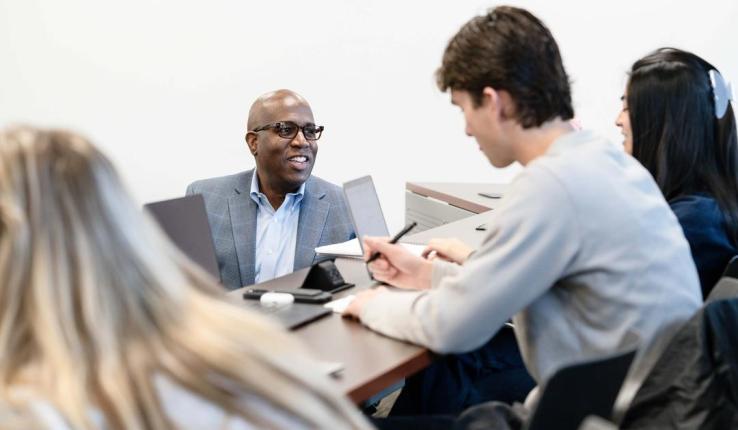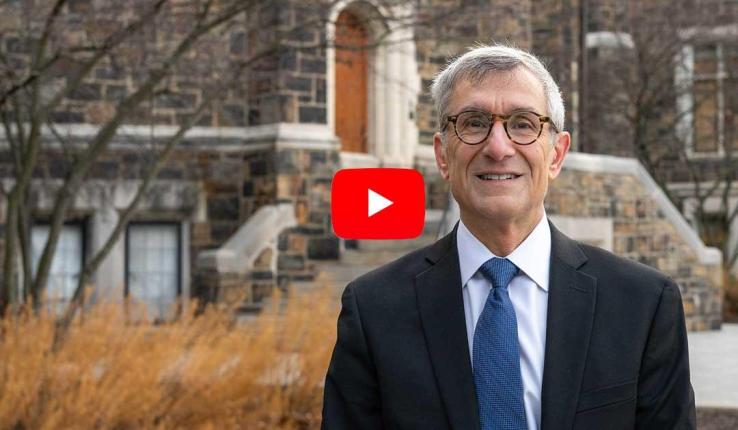Larry Snyder is a cruciverbalist. And if you enjoy solving—or creating—crossword puzzles, you are, too.
People have enjoyed solving crossword puzzles for more than 100 years, and those that solved The New York Times crossword on Friday, Feb. 23, worked on a puzzle designed and submitted by Snyder, deputy provost for faculty affairs and the Harvey E. Wagner Endowed Chair Professor in the P.C. Rossin College of Engineering and Applied Science.
"Industrial and systems engineering is a field that uses a lot of math and computing, and in many ways feels like solving puzzles," said Snyder. "It's gratifying to use that same part of my brain to create actual puzzles. Getting one published in the Times is a huge thrill."
The New York Times operates under an open submission policy, which means anyone can submit puzzles for consideration. According to the New York Times, the publication receives approximately 150 to 200 puzzle submissions weekly. Considering it prints seven per week, the odds of being published are low.
Snyder has been solving crossword puzzles sporadically for years, a hobby that became more regular during the idle days of the pandemic. In The New York Times, daily crossword puzzles are more challenging as the week progresses; during his early puzzle-solving days, Snyder doubted he could complete its Monday puzzle. Yet as he practiced, his skill became stronger, and he now solves its puzzles daily, in addition to others, when time permits.
In late 2022, he decided to move beyond solving and began constructing crossword puzzles. He admitted his first few puzzles were not his best work.
“I collaborated with more experienced puzzle constructors,” Snyder said, “and learned a lot from the Discord server Crosscord.”
Snyder first decides whether he is constructing a themed or themeless puzzle (Sunday through Thursday New York Times’ puzzles are themed; Friday and Saturday are unthemed, and the most difficult puzzles of the week). He says regardless of the puzzle type, the process almost always follows the same steps: theme entries (if any), grid, fill, clues.
Once he has an idea for a themed puzzle, Snyder chooses entries. That step involves quite a bit of brainstorming. He then builds a grid, adds theme entries, and adds the “fill” (non-themed entries). Snyder said there is software to do this, but it is designed to assist, not build the puzzle. After he constructs a filled grid, the final step is writing clues.
“The constructor makes choices about what words to use, and that's one way the constructor's ‘voice’ comes through,” Snyder said.
He often writes Python code to help with brainstorming themed puzzles.
“For example, the theme of one of my puzzles was ‘phrases whose words can come after DATE or TIME,’” Snyder said. “The revealer was DATE AND TIME, and the theme entries were phrases like PROM NIGHT (because PROM DATE and NIGHT TIME) and HOT SPRING (HOT DATE and SPRING TIME). I wrote Python code to find entries that would fit this pattern.”
He approaches themeless puzzles differently, focusing on “longer, more sparkly entries–fun or new or otherwise interesting words or phrases.”
The first step is building a grid with spaces for long answers, followed by searching for interesting entries that intersect with the rest of the puzzle.
“I try to avoid ‘crosswordese’—words like EPEE and AGLET that appear a lot in crosswords but not in everyday life,” Snyder said.
Once he is happy with the filled grid, he writes the clues.
Although this is his first New York Times puzzle, Snyder is no stranger to having his crosswords appear in major publications. His puzzles have been published in the Los Angeles Times, Universal Crossword (which publishes puzzles in The Philadelphia Inquirer, The Boston Globe, Miami Herald, and other major newspapers), and there is one scheduled for publication in USA Today. His puzzles have also appeared in subscription-based services AVCX and Modern Crossword. For the last year or so, he has also created crosswords for his father’s retirement community’s monthly newsletter.
“I think crosswords—both solving and constructing—help you think in flexible ways,” Snyder said. “Focusing on a crossword is a great way to calm a busy mind.”
Puzzled by crosswords? Snyder recommends this article for starting your crossword-solving journey.





